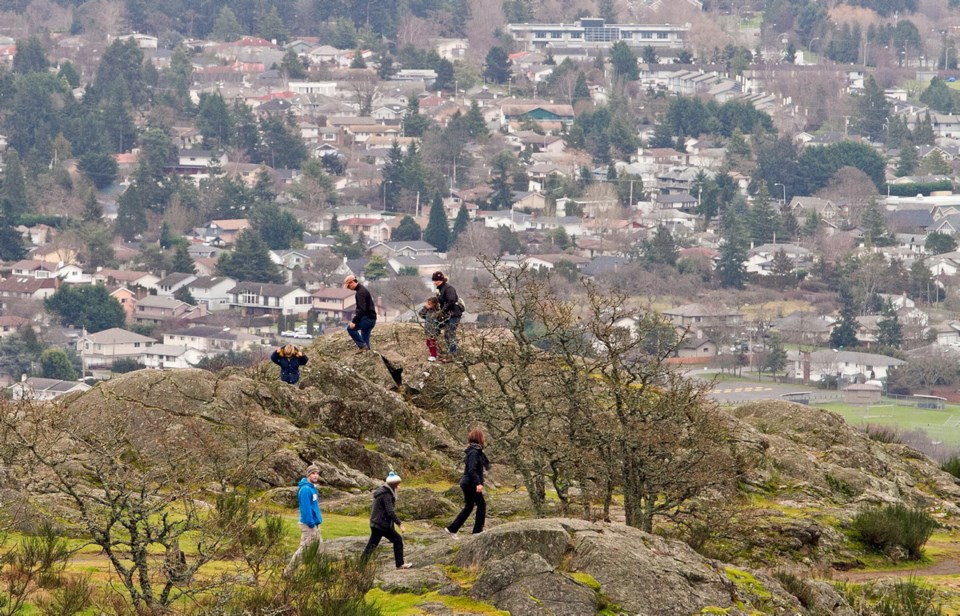The recent opening of provincial and federal parks in the region has taken some pressure off local parks that remained open throughout the past few months.
In mid-May, the B.C. government reopened many provincial parks for daytime use, including Goldstream, Sooke Potholes, Gowlland Todd and John Dean parks. Camping was allowed at some, beginning June 1, with local residents given priority access.
The government had closed all provincial parks in April in response to the pandemic.
June also saw trails, day-use areas and green spaces at some federal parks and historical sites reopen. National parks and historic sites closed mid-March.
The parks that remained open throughout the pandemic were local and regional sites. They have borne the brunt of the past few months.
With the COVID-19 shutdown closing gyms, exercise classes and in-school classes, people of all ages took to local green spaces, trails and beaches.
You can see the impact of that increased use. In Mount Douglas Park, for example, many hiking trails that were only about one-half to one metre wide in January now come with new and significantly wider pull-off areas to allow for physical distancing from passing trail users. Some sections of some trails have been degrading for a number of years, thanks to poor winter drainage and people not wanting to walk through mud, but those trail sections have now become tree-studded dirt clearings that a Riverdance troupe could toe and kick and prance down side by side. Many trails have also sprouted offshoots that cut sharply into what was once undergrowth.
Wildflower meadows there and in other local parks are now more criss-crossed than before, with more trails worn down to dirt.
The timing of the shutdown likely contributed to the impacts. Foot traffic on and off trail increased just as plants were starting to wake up in March. The year’s first new growth was starting to emerge from the soil just as increased trail-side trampling began. Soils made soft from late winter and spring rains don’t withstand traffic as well as hard, dry dirt does.
Some of the damage is understandable and expected, given the requirements to keep two metres away from passing-stranger trail users.
Other damage seems pointless and gratuitous. In Mount Doug park, for example, some of what would have been mere deer trails into the bush last year are now much-used people trails branching off here and there, seemingly everywhere. I used to confidently suggest Mount Doug park to people new to the area. I no longer do. The unofficial trail network could easily turn people around and get them lost.
In another Saanich park, known for spectacular spring wildflowers, signs that ask park users to stay on designated trails to protect recently restored ecological areas were ripped out of the ground and tossed aside. New trails now march right on through the (formerly) restored terrain.
These latter examples highlight some interesting considerations about us.
To contain the spread of COVID-19 in recent months, each of us has had to shift from a predominantly individualistic, me-first mindset to a community perspective. In just weeks, we had to switch putting our personal convenience, needs and desires first to prioritizing the needs of the community as a whole.
History demonstrates that community-level thinking is necessary to deal effectively with population-level emergencies.
But the coronavirus pandemic is only one of the population-level crises we are facing. Human activity over the past century has generated another global crisis that both threatens far more devastating and widespread damage and will be far more difficult than COVID-19 to turn around. Climate change and its effects — increased wildfire, spread of invasive species, failed crops, rising risks of disease and so on — also require all of us to put aside our individual needs and convenience and prioritize the greater good.
Yet we can’t make the effort to avoid trampling a well-signed sensitive area in a local park.
Our inability as individuals to stay on-trail to protect the very values that draw us to our treasured local green spaces in the first place doesn’t bode well for our ability to work together to solve the difficult challenges ahead.



